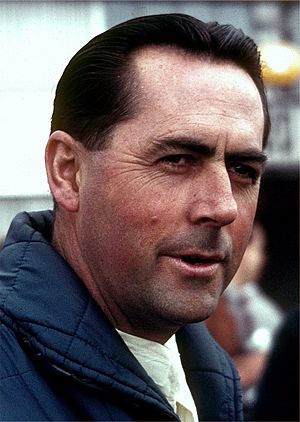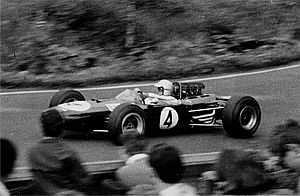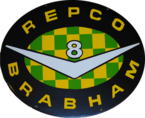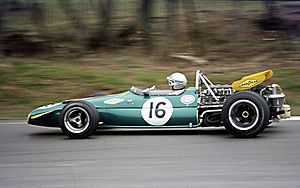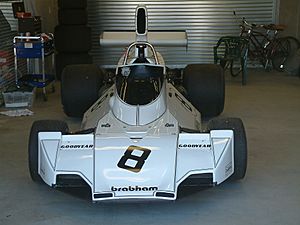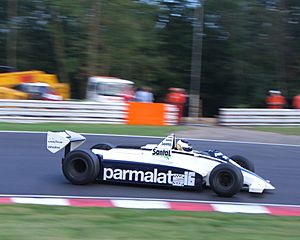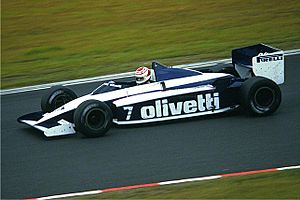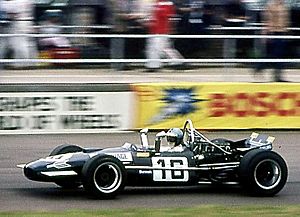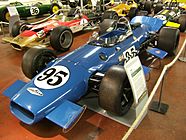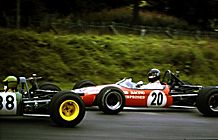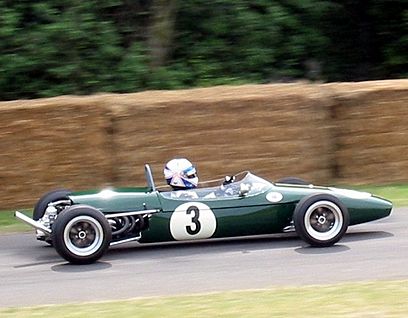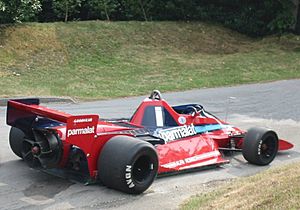Brabham facts for kids
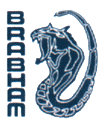 |
|
| Full name | Motor Racing Developments, Ltd. |
|---|---|
| Base | Chessington (1962–1989) and Milton Keynes (1990–1992), United Kingdom |
| Founder(s) | Jack Brabham Ron Tauranac |
| Noted staff | Bernie Ecclestone Gordon Murray Ron Dennis Charlie Whiting John Judd Herbie Blash |
| Noted drivers | |
| Formula One World Championship career | |
| First entry | 1962 German Grand Prix |
| Races entered | 403 entries (394 starts) |
| Engines | Climax, Repco, Ford, Alfa Romeo, BMW, Judd, Yamaha |
| Constructors' Championships |
2 (1966, 1967) |
| Drivers' Championships |
4 (1966, 1967, 1981, 1983) |
| Race victories | 35 |
| Podiums | 120 |
| Points | 832 |
| Pole positions | 40 |
| Fastest laps | 42 |
| Final entry | 1992 Hungarian Grand Prix |
Brabham was a famous British Formula One racing team and car maker. It was officially called Motor Racing Developments Ltd. The team was started in 1960 by Australian driver Jack Brabham and designer Ron Tauranac.
Over 30 years in Formula One, Brabham won four World Championships for drivers and two for constructors (the team title). Jack Brabham himself won the 1966 Drivers' Championship. This was special because he won it in a car named after himself!
In the 1960s, Brabham was the biggest maker of open-wheel racing cars for other teams to buy. By 1970, they had built over 500 cars. Brabham cars also won championships in other racing series like Formula Two and Formula Three. The team was known for new ideas. They were among the first to use in-race refuelling, carbon brakes, and special suspension systems. Their unique "fan car" even won its only race before rules changed.
In the 1980s, Brazilian driver Nelson Piquet won two more Formula One Drivers' Championships for Brabham. He won in 1981 and again in 1983. His 1983 win was the first time a driver won the championship with a turbocharged car.
British businessman Bernie Ecclestone owned Brabham for most of the 1970s and 1980s. He later became very important in running Formula One as a whole. Ecclestone sold the team in 1988. The team faced financial problems and stopped racing in 1992.
Contents
How Brabham Started
The Brabham team began with Jack Brabham and Ron Tauranac. They met in Australia in 1951, both building and racing cars successfully. Jack Brabham moved to the UK in 1955 to race more. He joined the Cooper team and won the Formula One World Drivers' Championship in 1959 and 1960. He drove Cooper's new cars, which had the engine behind the driver.
Even though Cooper had new ideas, they didn't always want to keep improving their cars. Jack Brabham wanted more changes. He helped develop Cooper's successful 1960 car with Ron Tauranac's help. Jack felt he could do better than Cooper. In 1959, he asked Ron to join him in the UK. Their goal was to design racing cars. Jack said Ron was "absolutely the only bloke I'd have gone into partnership with."
Jack and Ron created Motor Racing Developments Ltd. (MRD). They didn't use their names to avoid problems since Jack still worked for Cooper. Their first car was for the Formula Junior class. It was kept secret until 1961. The "MRD" car was soon renamed. A journalist pointed out that "MRD" sounded like a French word for something bad. So, the cars became known as Brabhams. Their model numbers started with BT, for "Brabham Tauranac."
By 1961, other teams like Lotus and Ferrari had improved the mid-engine idea even more. Jack Brabham had a tough season. He left Cooper in 1962 to race for his own team, the Brabham Racing Organisation. This team used cars built by Motor Racing Developments. Their base was in Chessington, England.
Brabham's Formula One Journey
Jack Brabham and Ron Tauranac (1961–1970)
Motor Racing Developments first focused on selling cars to other teams in smaller racing series. So, the new Formula One car wasn't ready until partway through the 1962 season. The Brabham Racing Organisation started with a car from another team, Lotus. Jack Brabham scored points in the Lotus. Then, the blue-green Brabham BT3 car made its first appearance at the 1962 German Grand Prix. It had some problems but later finished fourth twice.
From 1963, American driver Dan Gurney joined Brabham. The cars were now green and gold, Australia's racing colors. Jack Brabham won the team's first race in 1963, though it wasn't a championship event. Dan Gurney then won the team's first two world championship races in 1964. The 1965 season was not as good. Brabham finished third or fourth in the Constructors' Championship for three years. But sometimes, car problems stopped them from getting good results.
For the 1966 season, Formula One engines became bigger (3 liters). Good engines were hard to find. Brabham used engines from an Australian company called Repco. Repco had never made a Formula One engine before. Many people didn't think the Brabham-Repco cars would be fast. But the cars were light and reliable. They raced at the front from the start of the season. At the 1966 French Grand Prix, Jack Brabham became the first person to win a Formula One race in a car named after himself. He won his third championship in 1966.
In 1967, the championship went to Brabham's teammate, Denny Hulme from New Zealand. Hulme's car was more reliable that year. The Brabham team won the Constructors' World Championship in both 1966 and 1967.
In 1968, Jochen Rindt joined the team. Repco made a stronger engine, but it often broke down. The car was fast, and Rindt started from pole position twice. But Brabham and Rindt finished only three races together.
For 1969, Brabham used Cosworth DFV engines. Jacky Ickx joined the team. He had a strong second half of the season, winning two races. Ickx finished second in the Drivers' Championship. Brabham himself got two pole positions. The team finished second in the Constructors' Championship.
Jack Brabham planned to retire at the end of 1969. He sold his share of the team to Ron Tauranac. But Jack raced for one more year. He won his last race at the start of the 1970 season. The team finished fourth in the Constructors' Championship.
Ron Tauranac (1971)
Ron Tauranac signed two-time world champion Graham Hill and young Australian Tim Schenken for the 1971 season. Tauranac designed the unusual 'lobster claw' BT34 car. Graham Hill won his last Formula One race in this car, though it wasn't a championship event. The team only scored seven championship points that year.
Ron Tauranac was an engineer. He felt the Formula One budget was too risky for him alone. So, he looked for a business partner. At the end of 1971, he sold the company for £100,000 to British businessman Bernie Ecclestone. Ron stayed on to design the cars and run the factory.
Bernie Ecclestone (1972–1987)
Ron Tauranac left Brabham early in 1972. Bernie Ecclestone had changed how the company worked without asking Ron. The team had a difficult year, using three different car models. For 1973, Ecclestone made young South African engineer Gordon Murray the chief designer. He also made Herbie Blash the Formula One team manager. Both stayed with the team for 15 years. Murray designed the BT42, which helped Carlos Reutemann get two podium finishes.
In 1974, Reutemann won his first three Formula One races. These were Brabham's first wins since 1970. The team finished fifth in the Constructors' Championship with the much better BT44 cars. Many thought Brabham would win the 1975 title. The year started well with a win for Brazilian driver Carlos Pace. But as the season went on, tire wear often slowed the cars. Reutemann had five podium finishes, including a big win in Germany. He finished third in the Drivers' Championship. The team finished second in the Constructors' Championship.
Other teams like Lotus and McLaren used the Cosworth DFV engine. But Ecclestone wanted an advantage. He made a deal with Italian car maker Alfa Romeo to use their powerful flat-12 engine from 1976. The engines were free, but they made the new BT45 cars unreliable and too heavy. The 1976 and 1977 seasons saw Brabham fall behind again. Reutemann left the team. John Watson replaced him for 1977. Watson almost won the French Grand Prix but ran out of fuel on the last lap. The Alfa Romeo engine's unreliability was a big problem. Carlos Pace died in a plane accident early in 1977.
For 1978, Gordon Murray designed the BT46. It had new technologies to deal with the heavy Alfa Romeo engines. Ecclestone signed two-time world champion Niki Lauda from Ferrari. Lauda won two races in the BT46. One win was with the special "fan car" version, which caused some debate.
The partnership with Alfa Romeo ended in 1979. This was the team's first year with young Brazilian driver Nelson Piquet. Murray designed the BT48, which used ground effect (a way to make cars stick to the track). It also had new "carbon-carbon braking," which Brabham helped create. But the car's handling was tricky, and the new engine was unreliable. The team finished eighth in the Constructors' Championship. Alfa Romeo started testing their own Formula One car. So, Ecclestone went back to Cosworth DFV engines. The new, lighter BT49 was introduced late in 1979. Lauda announced his retirement from driving, saying he "was no longer getting any pleasure from driving."
The team used the BT49 for four seasons. In 1980, Piquet won three races. The team finished third in the Constructors' Championship, and Piquet was second in the Drivers' Championship. This season also saw the introduction of the blue and white colors that Brabham cars would wear until 1992. The team improved the BT49C for 1981. They added a special suspension system to get around rules about car height. Piquet won the drivers' title with three wins. The team finished second in the Constructors' Championship.
Renault had introduced turbocharged engines to Formula One in 1977. Brabham tested a BMW turbocharged engine in 1981. For 1982, the team designed a new car, the BT50, around the BMW engine. Brabham also used the Cosworth-powered BT49D early in the season while they fixed problems with the BMW engines. The turbo car won its first race in Canada. The team finished fifth in the Constructors' Championship. In 1983, Piquet won the championship at the last race of the year. He became the first driver to win the Formula One Drivers' World Championship with a turbo-powered car. The team did not win the Constructors' Championship in 1981 or 1983, even with Piquet's success.
Piquet got the team's last wins: two in 1984 and one in 1985. After seven years and two world championships, Piquet left for the Williams team at the end of 1985.
For 1986, Riccardo Patrese returned to Brabham, joined by Elio de Angelis. The season was very bad for Brabham, scoring only two points. Gordon Murray's new BT55 car had many reliability problems. De Angelis sadly died in a testing accident.
In August, BMW announced they would leave Formula One. Murray, who was running the team more as Ecclestone focused on his Formula One role, felt the team was breaking down. He left Brabham in November to join McLaren.
Ecclestone kept BMW to their contract for 1987. But BMW only supplied a certain type of engine. The 1987 season was only a little better than 1986. Patrese and Andrea de Cesaris scored 10 points. The team couldn't find a good engine supplier. They missed the deadline for the 1988 championship. Ecclestone announced the team was leaving Formula One. He then sold Motor Racing Developments to Walter Brun.
Joachim Lüthi (1989)
Brun soon sold the team to Swiss businessman Joachim Lüthi. He brought it back to Formula One for the 1989 season. The new Brabham BT58 used a Judd V8 engine. Italian driver Stefano Modena and Martin Brundle drove for the team. Modena got the team's last podium finish: a third place at the Monaco Grand Prix. The team sometimes failed to qualify for races. They finished ninth in the Constructors' Championship.
Middlebridge Racing (1989–1992)
After Lüthi faced legal issues in 1989, several groups wanted to own the team. Middlebridge Group Limited, a Japanese engineering company, took control of Brabham for the 1990 season. Herbie Blash returned to run the team. Middlebridge bought the team with a loan, but the team still didn't have enough money. They only scored a few more points in their last three seasons.
Jack Brabham's youngest son, David Brabham, raced for the team for a short time in 1990. 1990 was a very difficult year. The team finished ninth in the Constructors' Championship. Brundle and Mark Blundell scored only three points in 1991. The team finished 10th in the Constructors' Championship. The 1992 season started with Eric van de Poele and Giovanna Amati. Damon Hill, the son of another former Brabham driver, joined the team later. Amati was the fifth woman to race in Formula One, but she didn't qualify for three races.
Argentine designer Sergio Rinland designed the team's final cars. They used Judd engines, except in 1991 when Yamaha powered the cars. In 1992, the cars rarely qualified for races. Damon Hill gave the team its last finish at the Hungarian Grand Prix. He finished 11th, four laps behind the winner. After that race, the team ran out of money and closed down.
Middlebridge Group Limited couldn't pay back their loans. The team's assets were sold in 1993. Brabham was one of four teams to leave Formula One that year.
Motor Racing Developments (MRD)
Brabham cars were also used by many other teams, not just in Formula One. Jack Brabham and Ron Tauranac created Motor Racing Developments (MRD) in 1961. This company designed and built racing cars for other teams to buy. Jack and Ron each owned half of the company. Ron was in charge of design and business. Jack was the test driver and made deals for engines and testing. He also helped design and build the cars.
From 1963 to 1965, MRD didn't directly run the Formula One team. Jack Brabham's Brabham Racing Organisation ran the Formula One cars. This team bought its cars from MRD. Ron Tauranac wasn't happy with this setup. Before the 1966 season, they made a new agreement. From 1966, MRD was much more involved in Formula One. After Jack Brabham sold his shares to Ron Tauranac in 1969, MRD became the official Formula One team.
Even though MRD built its first car in 1961, it quickly became the biggest maker of single-seat racing cars in the world by the mid-1960s. By 1970, they had built over 500 cars. Other Formula One teams like Frank Williams Racing Cars and Rob Walker Racing Team had success using Brabhams. In the 1965 British Grand Prix, seven Brabhams raced, but only two were from the main team. The company built many cars for smaller racing series each year. Brabham was known for giving customers cars that were just as good as the main team's cars. They also offered great support to their customers.
At the end of 1971, Bernie Ecclestone bought MRD. He kept the Brabham name. He believed the company needed to focus only on Formula One. The last customer Brabhams were made in 1973.
In 1988, Ecclestone sold Motor Racing Developments to Alfa Romeo. The Formula One team didn't race that year. But Alfa Romeo used the company to design a "Procar." This was a racing car that looked like a regular car but had a special racing chassis and engine inside. It was called the Brabham BT57.
Brabham in Other Races
IndyCar
Brabham cars also raced in the Indianapolis 500 from the mid-1960s to the early 1970s. In 1964, MRD built an IndyCar chassis with an American Offenhauser engine. Jack Brabham raced this car. It didn't finish the 1964 race but took third place in 1966 with Jim McElreath. Brabham returned to Indianapolis from 1968 to 1970. They used a larger version of their Formula One engine. Peter Revson finished fifth in 1969.
Even though no Brabham car won the Indianapolis 500, Jim McElreath won four other USAC races in 1965 and 1966. The car Mario Andretti used to win the 1965 USAC national championship was a copy of the Brabham car. Revson got Brabham's last USAC race win in 1969.
Formula Two
In the 1960s and early 1970s, Formula One drivers often raced in Formula Two too. In 1966, MRD made the BT18 for Formula Two. It used a Honda engine. This car was very successful. It won 11 Formula Two races in a row with Jack Brabham and Denny Hulme driving.
Formula Three
The first Formula Three Brabham, the BT9, won only four major races in 1964. The BT15 in 1965 was a very successful design. 58 cars were sold, and they won 42 major races. Later versions of this car, which added wings, were also very competitive until 1971. The BT38C of 1972 was Brabham's first car with a monocoque (a strong, single-piece body). It was less successful. The BT41 was the last Formula Three Brabham.
Formula 5000
Brabham made one car for Formula 5000 racing, the Brabham BT43. It was tested in late 1973 and early 1974. Kevin Bartlett used a Chevrolet-powered Brabham BT43 to finish third in the 1978 Australian Drivers' Championship.
Sports Cars
Ron Tauranac didn't really enjoy designing sports cars. So, he spent little time on them. Only 14 sports car models were built between 1961 and 1972. The BT8A was the most common and was quite successful in UK races in 1964 and 1965. The BT17 was a one-off car made in 1966 for Can-Am racing. It had engine problems and was soon stopped.
New Ideas and Technology
In the 1960s, Brabham was seen as a bit old-fashioned. They kept using traditional "spaceframe" cars. This was long after Lotus started using lighter, stronger "monocoque" chassis in 1962. Designer Ron Tauranac thought monocoques weren't much stiffer then. He also felt they were harder to fix and not as good for customers. But his "old fashioned" cars helped Brabham win championships in 1966 and 1967.
Despite this, Brabham was the first Formula One team in 1963 to use a wind tunnel. This helped them make their cars more aerodynamic. It reduced drag and stopped the cars from lifting off the ground at high speeds. This practice became normal in the 1980s and is now very important for car design. In the late 1960s, teams started using aerodynamic "downforce." This pushed the car's tires harder onto the track, allowing faster speeds in corners. At the 1968 Belgian Grand Prix, Brabham was one of the first to use full-width rear wings for this purpose.
The team's most innovative time was in the 1970s and 1980s with Gordon Murray as technical director. In 1976, Brabham introduced carbon-carbon brakes to Formula One. These brakes were lighter and stopped the car better. At first, they weren't reliable. But by 1979, Brabham had a very effective carbon-carbon braking system. By the late 1980s, all top motor sports teams used carbon brakes.
In 1978, the Brabham BT46B "Fan car" created huge downforce. It had a fan that sucked air from under the car. It was said the fan was for engine cooling. This car raced only once in the Formula One World Championship, with Niki Lauda winning. Then, the rules were changed to ban it.
In 1979, Murray was the first to use light carbon fiber composite panels to make Brabham's aluminum car bodies stiffer. However, he was the last to switch to full composite bodies. Murray wanted to understand how they behaved in a crash first. The team didn't use a full composite chassis until the BT55 in 1986. Now, all top single-seater racing cars use this technology.
For the 1981 season, Formula One introduced a minimum car height rule. This was meant to slow cars down by reducing downforce. Gordon Murray designed a special suspension system for the BT49C. It allowed the car to sit much lower at high speeds. Other teams accused Brabham of cheating. But Murray believed the system followed the rules. No action was taken, and other teams soon made similar systems.
At the 1982 British Grand Prix, Brabham brought back the idea of refuelling and changing tires during the race. This hadn't been seen since 1957. It allowed drivers to start races with less fuel and softer tires, making them faster. The team learned techniques from IndyCar and NASCAR racing. They could refuel and change tires in 14 seconds in tests. In 1983, the team used this tactic well. Refuelling was banned for 1984, but tire changes are still part of Formula One.
What Happened to the Brabham Name?
Attempts to Bring it Back
In 2009, a German group tried to enter the 2010 Formula One season using the Brabham name. But the Brabham family was not involved. They said they would take legal action. The team's entry was not accepted. The Brabham family later got legal rights to the Brabham name.
Brabham Racing
In 2014, David Brabham (Jack Brabham's son) announced he was bringing back the Brabham Racing team. It was called Project Brabham. They planned to enter the 2015 FIA World Endurance Championship and the 24 Hours of Le Mans. They wanted to use a new way of funding the team, called crowdsourcing. The company also thought about returning to Formula One, but they didn't have enough money.
In 2019, Brabham Automotive said they wanted to enter the 2021 FIA World Endurance Championship with their BT62 car. The team raced in the 2019 GT Cup Championship. They also entered the last two races of the 2019 Britcar Endurance Championship and won on their first try.
In 2021, Brabham Automotive showed their BT63 GT2 car for the first time at the end of the 2021 GT2 European Series season.
Championship Results
Here are the results for the main Brabham team. Bold means they won a championship.
| Season | Entrant | Car | Tyres | Engine | Drivers | Constructors' Championship |
|---|---|---|---|---|---|---|
| 1962 | Brabham Racing Organisation | Lotus 24 Brabham BT3 |
D | Coventry Climax FWMV | Jack Brabham | 7th (9 points) |
| 1963 | Brabham Racing Organisation | Brabham BT3 Brabham BT7 Lotus 25 |
D | Coventry Climax FWMV | Jack Brabham Dan Gurney |
3rd (28 points) |
| 1964 | Brabham Racing Organisation | Brabham BT7 Brabham BT11 |
D | Coventry Climax FWMV | Jack Brabham Dan Gurney |
4th (33 points) |
| 1965 | Brabham Racing Organisation | Brabham BT7 Brabham BT11 |
D | Coventry Climax FWMV | Jack Brabham Dan Gurney Denny Hulme Giancarlo Baghetti |
3rd (27 pts) |
| 1966 | Brabham Racing Organisation | Brabham BT19 Brabham BT20 Brabham BT22 |
G | Repco 620 Coventry Climax FPF |
Jack Brabham Denny Hulme |
Champion (42 pts) |
| 1967 | Brabham Racing Organisation | Brabham BT19 Brabham BT20 Brabham BT24 |
G | Repco 620 Repco 740 |
Jack Brabham Denny Hulme |
Champion (37 pts) |
| 1968 | Brabham Racing Organisation | Brabham BT24 Brabham BT26 |
G | Repco 740 Repco 860 |
Jack Brabham Jochen Rindt Dan Gurney |
8th (10 pts) |
| 1969 | Motor Racing Developments | Brabham BT26A | G | Cosworth DFV | Jack Brabham Jacky Ickx |
2nd (51 pts) |
| 1970 | Motor Racing Developments | Brabham BT33 | G | Cosworth DFV | Jack Brabham Rolf Stommelen |
4th (35 pts) |
| 1971 | Motor Racing Developments | Brabham BT33 Brabham BT34 |
G | Cosworth DFV | Graham Hill Tim Schenken Dave Charlton |
9th (5 pts) |
| 1972 | Motor Racing Developments | Brabham BT33 Brabham BT34 Brabham BT37 |
G | Cosworth DFV | Graham Hill Carlos Reutemann Wilson Fittipaldi |
9th (7 pts) |
| 1973 | Motor Racing Developments Ceramica Pagnossin Team MRD |
Brabham BT37 Brabham BT42 |
G | Cosworth DFV | Carlos Reutemann Wilson Fittipaldi Andrea de Adamich Rolf Stommelen John Watson |
4th (49 pts) |
| 1974 | Motor Racing Developments | Brabham BT42 Brabham BT44 |
G | Cosworth DFV | Carlos Reutemann Carlos Pace Rikky von Opel Richard Robarts Teddy Pilette |
5th (35 pts) |
| 1975 | Martini Racing | Brabham BT44B | G | Cosworth DFV | Carlos Reutemann Carlos Pace |
2nd (54 pts) |
| 1976 | Martini Racing | Brabham BT45 | G | Alfa Romeo 115-12 | Carlos Reutemann Carlos Pace Rolf Stommelen Larry Perkins |
9th (9 pts) |
| 1977 | Martini Racing | Brabham BT45B | G | Alfa Romeo 115-12 | Carlos Pace John Watson Hans-Joachim Stuck Giorgio Francia |
5th (27 pts) |
| 1978 | Parmalat Racing Team | Brabham BT45C Brabham BT46/B/C |
G | Alfa Romeo 115-12 | Niki Lauda John Watson Nelson Piquet |
3rd (53 pts) |
| 1979 | Parmalat Racing Team | Brabham BT46 Brabham BT48 Brabham BT49 |
G | Alfa Romeo 115-12 Alfa Romeo 1260 Cosworth DFV |
Niki Lauda Nelson Piquet Ricardo Zunino |
8th (6 pts) |
| 1980 | Parmalat Racing Team | Brabham BT49/B | M | Cosworth DFV | Nelson Piquet Ricardo Zunino Héctor Rebaque |
3rd (55 pts) |
| 1981 | Parmalat Racing Team | Brabham BT49/B/C | M | Cosworth DFV | Nelson Piquet Héctor Rebaque Ricardo Zunino |
2nd (61 pts) |
| 1982 | Parmalat Racing Team | Brabham BT49D Brabham BT50 |
G | Cosworth DFV BMW M12/13 |
Nelson Piquet Riccardo Patrese |
5th (41 pts) |
| 1983 | Fila Sport | Brabham BT52/B | M | BMW M12/13 | Nelson Piquet Riccardo Patrese |
3rd (72 pts) |
| 1984 | MRD International | Brabham BT53 | M | BMW M12/13 | Nelson Piquet Teo Fabi Corrado Fabi Manfred Winkelhock |
4th (38 pts) |
| 1985 | Motor Racing Developments Ltd | Brabham BT54 | P | BMW M12/13 | Nelson Piquet Marc Surer François Hesnault |
5th (26 pts) |
| 1986 | Motor Racing Developments Ltd | Brabham BT54 Brabham BT55 |
P | BMW M12/13/1 | Elio de Angelis Riccardo Patrese Derek Warwick |
9th (2 pts) |
| 1987 | Motor Racing Developments Ltd | Brabham BT56 | G | BMW M12/13/1 | Riccardo Patrese Andrea de Cesaris Stefano Modena |
8th (10 pts) |
| 1989 | Motor Racing Developments | Brabham BT58 | P | Judd EV | Martin Brundle Stefano Modena |
9th (8 pts) |
| 1990 | Motor Racing Developments | Brabham BT58 Brabham BT59 |
P | Judd EV | Stefano Modena David Brabham Gregor Foitek |
10th (2 pts) |
| 1991 | Motor Racing Developments Ltd | Brabham BT59Y Brabham BT60Y |
P | Yamaha OX99 | Martin Brundle Mark Blundell |
9th (3 pts) |
| 1992 | Motor Racing Developments Ltd | Brabham BT60B | G | Judd GV | Eric van de Poele Giovanna Amati Damon Hill |
NC (0 pts) |
See also
 In Spanish: Brabham Racing Organisation para niños
In Spanish: Brabham Racing Organisation para niños
- List of Brabham race cars


